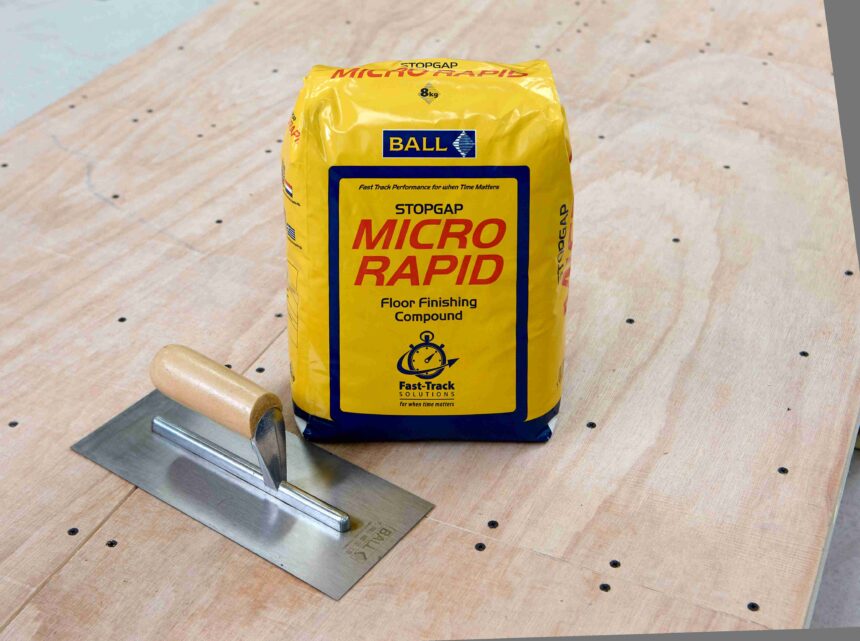Ensuring a Perfectly Smooth Subfloor

Ensuring a smooth base for the receipt of floorcoverings is essential for achieving a visually attractive flooring finish, especially when installing thin resilient floorcoverings. John Green, Technical Service Officer at F. Ball and Co. Ltd., details steps for when a flawlessly smooth subfloor finish is required.
Contractors should begin any flooring installation by ensuring the subfloor is suitably sound, smooth and dry enough for the receipt of new floorcoverings. As part of this, F. Ball recommends the application of a smoothing compound to achieve a smooth base. There are also situations where additional preparations will be required to achieve a perfectly smooth surface for floorcoverings; for example, where sand/cement screeds are mechanically damaged or when working over a plywood base.
Before they go any further, it is recommended that contractors conduct a moisture test to determine subfloor moisture levels. Where relative humidity (RH) levels within the subfloor are above 75% (65% if wood floorcoverings are to be installed), the application of a waterproof surface membrane will be required before floorcoverings are installed. If not treated, high levels of humidity within the subfloor can lead to discolouration of the floorcovering and loss of bond strength between the layers above, ultimately resulting in floor failure.
Plywood Subfloors
When working over plywood subfloors, gaps at joins between panels, as well as holes caused by screws used to affix them to the substrate, should be filled. Otherwise, imperfections can transfer to subsequently applied floorcoverings, which can compromise the appearance of the finished installation. This is no more important than when installing thin resilient floorcoverings, such as LVTs.
Floor finishing compounds are available for this purpose. F. Ball has developed Stopgap Micro Rapid, an ultra-smooth, flexible, rapid-drying floor finishing compound for creating a flawless subfloor finish. The product can be applied to a seamless micro feathered edge to fill indentations formed by screws used to secure plywood and hardboard sheets and gaps at joins. It can also be used to repair minor surface defects in a wide range of other absorbent surfaces, including sand/cement and calcium sulphate screeds.
Stopgap Micro Rapid utilises the same advanced cement technology as the company’s fast-track smoothing compounds. It is walk-on hard and ready to receive new floorcoverings from just 20 minutes after application, and priming is not required prior to use, making it perfect for use when working to tight time constraints and deadlines.
Repair Compounds
In the case that a contractor finds that the subfloor has dormant, non-structural cracks or holes in it, which may be the case where sand/cement screeds have been mechanically damaged, a suitable repair compound should be used to fill in the gaps. Stopgap 400 Repair is a fast-setting, rapid-drying repair compound that can be applied in thicknesses between 2-50mm to repair internal floors in light to heavy duty areas. The product can also be used to fill gaps in tiled areas where individual ceramic tiles are missing.
Where excess subfloor moisture is detected, contractors should use a repair compound that is designed for use in damp conditions, such as Stopgap 460 Exterior Repair, prior to the application of a waterproof surface membrane. Stopgap 460 is weather resistant, so it can be also used to repair external floors as part of refurbishment projects.
Next Steps
Once a repair or finishing compound has dried, contractors can then proceed with the application of a smoothing compound or installation of a new floorcovering in the usual way, remembering to prime the subfloor beforehand to promote the adhesion characteristics of smoothing compounds. When applied to absorbent surfaces, primers also stop the unacceptably rapid drying of subsequently applied smoothing compounds, maximising the working time of the product. Priming also prevents pinholing: tiny bubbles formed by the slow escape of air from the subfloor, which burst on reaching the surface, leaving small pinholes as the smoothing compound cures.
Finally, selection should be determined by the subfloor type and intended use. For when working over plywood subfloors, specialist smoothing compounds are available, such as Stopgap 700, which are better able to accommodate slight movements as a result of normal foot traffic. There are also smoothing compounds for other technical applications, including for areas that will be subject to heavy loads or high levels of foot traffic, ones with moisture tolerant properties and others that offer maximum compatibility with calcium sulphate screeds.